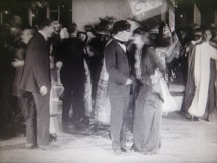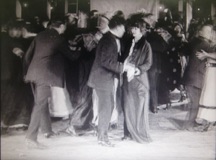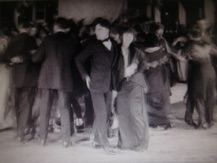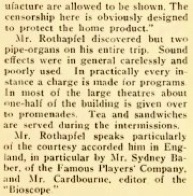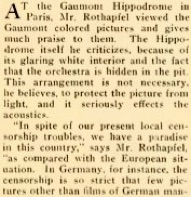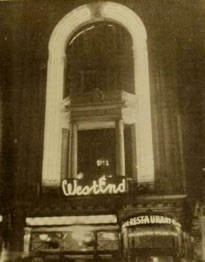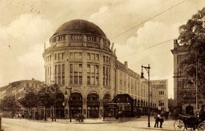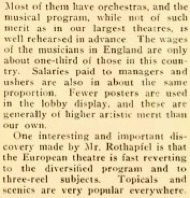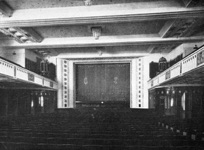Tango Tangles Clippings 12/27
Motion Picture News, New York, March 21, 1914
Tango Tangles Scenes
& Westend, exterior by night, London, London
Theater Uses Tube Lighting, Effective Front Display
(...) Motography, December 19, 1914
& Kammerlichtspiele, exterior by day, Berlin, 1914, postcard
& Kammerlichtspiele am Potsdamer Platz,
Zuschauerraum, Blick nach vorn, Berlin, in Hans Schliepmann,
Lichtspieltheater, Berlin 1914
„Pitch dark“
Editorial content. „America First in Picture Theatres
So Declares S. L. Rothapfel, After a Four-Week‘s Tour
of England and the Continent. Where He Has
Found Conditions Far Inferior to Those in This Country
,ONE year ago we were several years behind
Europe in the way of picture theatres. Today we are several
years ahead.‘
In this way Mr. S. L. Rothapfel sums up his trip abroad,
where he went in search of new ideas before opening the Strand Theatre, Broadway and Forty-eight street.
Mr. Rothapfel returned March 4 on the S. S. ,Kaiser
Wilhelm II.‘ after a four-weeks‘ trip. In this limited time
Mr. Rothapfel was only able to inspect the theatres of London
and the larger continental cities. He found everywhere
a lack of artistic interiors and a presentation of the picture which compared in no way with the recent developements at the
Regent and other high-class American theatres.
All the European houses are pitch dark while the
pictures are being shown. During the intermission the lights
are turned on with full illumination, making a distressing
glare over an interior that is glaring in itself, and, in the case of
many German theatres, crudely and vulgarly decorated.
Mr. Rothapfel had considerable difficulty in persuading
the foreign exhibitor that the American theatre is well
lighted during the performance. The daylight picture is practically
unknown abroad. He found that many of the exhibitors
had introduced the shadow box, which Mr. Rothapfel originated
in this country.
The most artistic theatre on the continent, and one
of the best conducted, is the ,Edouard VII‘ in Paris, owned
and managed by the Kinemacolor Company.
The London theatres do not compare with the large,
modern American theatre.
At the West End Theatre, which is the second largest
in London, Mr. Rothapfel viewed the production of
Anthony and Cleopatra. It was spoiled, in his estimation,
by a bad musical program.
The interior decoration of the ,Kammerlichspiel‘ of Berlin,“
Kammerlichtspiele im Haus Vaterland, Potsdamer Platz,
Köthener Strasse 1-5. „were, to his mind, loud and gloriously
vulgar.
The theatres in Paris have no safety exits, and even
the center aisle is almost closed by the process of turning down
the end seats from either side into the aisle.
Another curious fact that came to Mr. Rothapfel‘s
observation was that many of the largest theatres on
the Continent were operated with but one projection machine.
Uniformly, the music in the English theatres
is considerably better than in the average American theatre.
Most of them have orchestras, and the musical program,
while not of such merit as in our largest theatres,
is well rehearsed in advance. The wages of the musicians
in England are only about one-third of those in this
country. Salaries paid to managers and ushers are also
about the same proportion. Fewer posters are used
in the lobby display, and these are generally of higher artistic
merit than our own.
One interesting and important discovery made by Mr.
Rothapfel is that European theatre is fast reverting
to the diversified program and to three-reel subjects. Topicals
and scenics are very popular everywhere.
At the Gaumont Hippodrome in Paris, Mr. Rothapfel
viewed the Gaumont colored pictures and gives much praise
to them. The Hippodrome itself he criticizes, because
of its glaring white interior and the fact that the orchestra is
hidden in the pit. This arrangement is not necessary,
he believes, to protect the picture from light, and it seriously
effects the acoustics.
,In spite of our present local censorship troubles, we
have a paradise in this country,‘ says Mr. Rothapfel,
,as compared with the European situation. In Germany, for
instance, the censorship is so strict that few pictures
other than films of German manufacture are allowed to be
shown. The censorship here is obviously designed
to protect the home product.‘
Mr. Rothapfel discovered but two pipe-organs on his
entire trip. Sound effects were in general carelessly
and poorly used. In practically every instance a charge is made
for programs. In most of the largest theatres about
one-half of the building is given over to promenades. Tea and sandwiches are served during the intermissions.
Mr. Rothapfel speaks particularly of the courtesy
accorded him in England, in particular by Mr. Sydney Baber,
of the Famous Players‘ Company, and Mr. Cardbourne,
editor of the ,Bioscope.‘“
Redaktioneller Inhalt
Motography, January 10 & February 7, 1914
Motion Picture News, March 7, 1914
America First in Picture Theatres
Motion Picture News, New York, March 21, 1914
Handsome Picture House Is New York‘s Strand
Variety, New York, April 10, 1914
Broadway Likes Motion Pictures
New York Tribune, New York, April 19, 1914
W. Stephen Bush, The Art of Exhibition, Moving Picture World,
New York, October 3, 1914
After Film Inspection New Yorks‘s Ultra-Progressive
Manager Gets Essanay-Chaplin Comedy for Rialto Theatre,
Beginning May 21, Advertisement,
Moving Picture World, New York, May 27, 1916
„Roxie“ S. L. Rothafel, A Bit About Myself,
Radio Broadcast, Garden City, New York, October 1923
James C. Young, Broadcasting Personality.
How S. L. Rothafel, Better Known as „Roxie,“ Brings
the Human Touch to Radio in His Famous Sunday Evening
Capitol Theatre Concerts Sent from WEAF, WJAR, and WCAP,
Radio Broadcast, Garden City, New York, July 1924
Heinz Liepmann, At the Chaplin Film With Chaplin,
World Film News, London, April 1936

